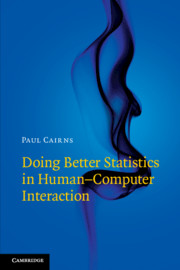Book contents
- Frontmatter
- Dedication
- Contents
- Figures
- Tables
- Acknowledgements
- Getting Started
- Part I Why We Use Statistics
- Part II How to Use Statistics
- 5 Planning Your Statistical Analysis
- 6 A Cautionary Tail: Why You Should Not Do a One-Tailed Test
- 7 Is This Normal?
- 8 Sorting Out Outliers
- 9 Power and Two Types of Error
- 10 Using Non-Parametric Tests
- 11 A Robust t-Test
- 12 The ANOVA Family and Friends
- 13 Exploring, Over-Testing and Fishing
- 14 When Is a Correlation Not a Correlation?
- 15 What Makes a Good Likert Item?
- 16 The Meaning of Factors
- 17 Unreliable Reliability: The Problem of Cronbach’s Alpha
- 18 Tests for Questionnaires
- Index
13 - Exploring, Over-Testing and Fishing
from Part II - How to Use Statistics
Published online by Cambridge University Press: 26 January 2019
- Frontmatter
- Dedication
- Contents
- Figures
- Tables
- Acknowledgements
- Getting Started
- Part I Why We Use Statistics
- Part II How to Use Statistics
- 5 Planning Your Statistical Analysis
- 6 A Cautionary Tail: Why You Should Not Do a One-Tailed Test
- 7 Is This Normal?
- 8 Sorting Out Outliers
- 9 Power and Two Types of Error
- 10 Using Non-Parametric Tests
- 11 A Robust t-Test
- 12 The ANOVA Family and Friends
- 13 Exploring, Over-Testing and Fishing
- 14 When Is a Correlation Not a Correlation?
- 15 What Makes a Good Likert Item?
- 16 The Meaning of Factors
- 17 Unreliable Reliability: The Problem of Cronbach’s Alpha
- 18 Tests for Questionnaires
- Index
Summary
The focus of statistical tests on significance can lead researchers to desperately seek significance, particularly when an experiment has 'failed'. However, this chapter tries to make clear, using the framework of severe testing, the problem of seeking significance at any cost and the resulting weakening of results based on over-testing or fishing for significance. The chapter proposes some rules to guide the researcher to both explore data thoroughly but not go too far in pursuit of significance.
- Type
- Chapter
- Information
- Doing Better Statistics in Human-Computer Interaction , pp. 155 - 166Publisher: Cambridge University PressPrint publication year: 2019

